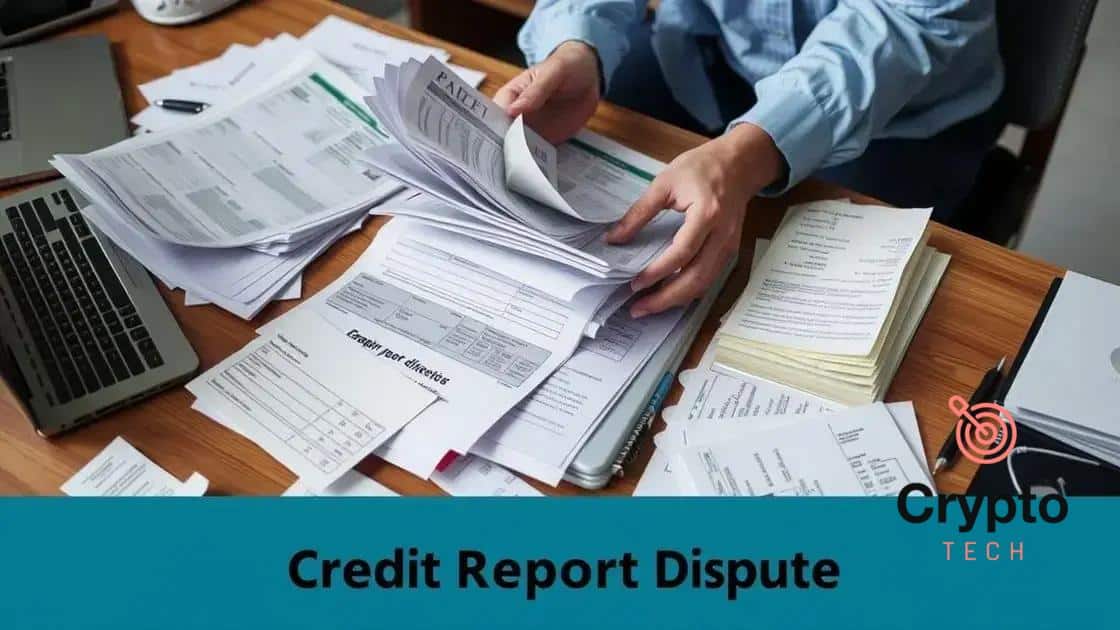How to dispute a credit report error effectively

To dispute a credit report error, gather supporting evidence, write a clear dispute letter to the credit bureau, and follow up on the investigation to ensure your credit report is accurate.
Have you ever noticed inaccuracies in your credit report? Learning how to dispute a credit report error can significantly improve your financial health. Let’s dig into the steps you can take to correct these mistakes and enhance your credit score.
Understanding credit report errors
Understanding credit report errors is crucial for your financial health. A credit report reflects your borrowing history and can greatly affect your credit score. When there are mistakes, they can lead to lower scores and affect your ability to borrow money or secure good interest rates.
It’s important to know what types of errors can occur on your credit report. Here are some common examples:
Types of Credit Report Errors
- Incorrect personal information: Errors in your name, address, or social security number.
- Account issues: Mistakes related to account balances or payment history.
- Fraudulent accounts: Accounts opened in your name without your consent.
- Outdated information: Information that should have been removed, like old debts.
Recognizing these errors early is key. Checking your credit report regularly helps spot inaccuracies. If you notice any of the issues mentioned above, take action! The sooner you address them, the better your credit standing will be.
For example, if you see a late payment listed that you believe is incorrect, gather your documentation to support your claim. This can include bank statements or payment confirmations. Disputing errors can be simple if you have the right evidence.
Why It Matters
Understanding credit report errors can empower you. It allows you to take control of your financial situation. By correcting mistakes, you can improve your chances of getting approved for loans or credit cards.
A clean credit report translates to better rates and terms. This means saving money in the long run. Therefore, regularly reviewing your credit is not just a good practice; it is essential. Credit errors can happen to anyone, so staying vigilant is important.
Common types of credit report mistakes

Common types of credit report mistakes can seriously impact your financial life. Recognizing these errors is the first step in disputing a credit report error effectively. Understanding what to look for can help you keep your credit report clean and accurate.
Many people encounter various errors on their credit reports. These can be grouped into a few categories. Here are some typical mistakes:
Personal Information Errors
- Incorrect spelling: Misspellings of your name or other details.
- Wrong address: Previous addresses listed that do not belong to you.
- Identity mix-up: Confusion with another person’s credit report.
These errors might seem minor, but they can affect your credit score and lead to future problems. It’s important to verify this information regularly.
Account Information Errors
Account information errors are another common issue. They can include wrong account statuses or balances. For example, you may see:
- Open accounts marked as closed: This can negatively impact your score.
- Late payments inaccurately reported: There should not be a late fee listed if you paid on time.
Such inaccuracies can lead lenders to unfairly assess your creditworthiness. So, always review the details of your accounts on your credit report.
Fraudulent Accounts
Sometimes, fraudulent accounts show up on your report. These are accounts opened without your knowledge. If you see any unfamiliar accounts, it’s crucial to act immediately. Report any fraud to the credit bureaus and take the necessary steps to protect your identity.
Credit report mistakes can seem overwhelming. However, by understanding these common issues, you can take proactive steps to correct them. Make it a habit to check your credit report regularly. This way, you’ll be better prepared to dispute any inaccuracies.
Step-by-step guide to disputing errors
Disputing errors on your credit report is a crucial process that can improve your credit standing. Knowing the steps to take helps ensure that you address inaccuracies promptly and effectively.
The first step in this process is to gather your documents. This includes any paperwork that supports your claim, such as receipts, statements, or letters. Having evidence on hand makes it easier to present your case.
Step 1: Obtain Your Credit Report
Request a copy of your credit report from the three major credit bureaus: Experian, TransUnion, and Equifax. You are entitled to one free report from each bureau each year. Check for errors and make a note of anything that seems incorrect.
Step 2: Identify the Errors
Once you have your report, identify the errors you want to dispute. Common mistakes include incorrect personal information, fraudulent accounts, and wrong account statuses. Make a detailed list of each error, including the location on the report for reference.
Step 3: Write a Dispute Letter
Next, draft a dispute letter to the credit bureau. Include your name, address, and phone number. Clearly state the inaccurate information and explain why it is incorrect. Attach copies of your supporting documents to validate your claim. You can use templates available online to make this process easier.
Step 4: Send Your Dispute
Mail your dispute letter via certified mail for tracking. This provides proof that you submitted your dispute. Be sure to keep copies of everything you send for your records.
Step 5: Follow Up
After about 30 days, contact the credit bureau to confirm they received your dispute. They are required to investigate the issue within this timeframe. You will receive a response indicating the outcome of your dispute.
If the bureau finds in your favor, they will update your report accordingly. If not, you can request a copy of their findings. Remember, it’s important to keep monitoring your credit report even after disputing errors.
Gathering evidence for your dispute

Gathering evidence for your dispute is a vital step in correcting mistakes on your credit report. Having solid proof can significantly enhance your chances of successfully disputing an error. Understanding what documents to collect is key.
The first part of your evidence should focus on any relevant accounts. Start by collecting statements from your bank or any financial institutions that show payments you’ve made. These documents can demonstrate payments made on time and support your claim if a late payment is inaccurately reported.
Documents to Gather
- Bank statements: These can help prove your payment history.
- Receipts: If you made payments that are in dispute, keep copies of receipts.
- Correspondence: Any communications you’ve had with lenders or credit bureaus regarding the disputed account.
- Credit report copies: Mark the errors directly on these documents to show what needs correcting.
As you collect these documents, organize them neatly. This can make it easier to refer back to them during the dispute process. If errors appear on multiple reports, gather items for each one. Make sure to take notes regarding each document and how it relates to the disputed items on your report.
In addition, if you suspect fraud, gather relevant evidence like police reports or fraud alerts. These records can help support your claims against the inaccuracies found in your credit report.
Having organized, clear pieces of evidence is essential. Not only does it help you when filing a dispute, but it also creates a stronger case for the credit bureaus to investigate your claims thoroughly.
Following up on your dispute process
Following up on your dispute process is essential to ensure that your claim is being addressed. Once you have submitted your dispute to the credit bureau, it’s important to stay proactive about what happens next.
Most credit bureaus are required to investigate your dispute within 30 days. During this time, continue to keep track of your communications. Make a note of when you sent your dispute and how you sent it. This can provide valuable information for later follow-ups.
Check the Status of Your Dispute
After about a month, check for updates on your dispute. You can do this by:
- Contacting the credit bureau: Call or send an email to inquire about the status.
- Online accounts: If you manage your credit report online, you might see updates directly on your profile.
- Written correspondence: Look for letters from the bureau regarding the results of their investigation.
Receiving a response will detail whether the disputed information has been corrected or remains unchanged. If the bureau confirms your dispute and updates your report, it’s a positive outcome. However, if the outcome is not in your favor, you still have options to consider.
Requesting Additional Action
If the dispute does not go as planned, you can ask for a more thorough investigation or provide additional evidence that supports your claim. This can include more documents or data that weren’t included in your original submission.
It’s also important to stay on top of your credit report even after disputing errors. You have the right to contest inaccuracies multiple times. Maintaining a good credit score relies on ongoing vigilance, so keep checking for any changes or new information.
Remember, diligence in following up on your disputes can help ensure that your credit report reflects accurate information, which in turn protects your financial health.
FAQ – Questions About Disputing Credit Report Errors
What should I do if I find an error on my credit report?
Gather evidence and write a dispute letter to the credit bureau detailing the inaccuracies.
How long does it take to resolve a dispute?
Credit bureaus are required to investigate disputes within 30 days and will inform you of the results.
Can I dispute an error multiple times?
Yes, you can dispute inaccuracies as many times as necessary until they are corrected.
What type of evidence do I need to support my dispute?
Documents such as bank statements, payment receipts, and correspondence with lenders can serve as supporting evidence.





